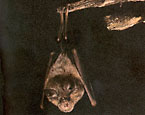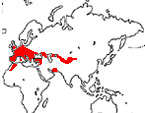|
Greater
Horseshoe Bat
(Rhinolophus ferrumequinum) |
||||
|
|
Physical
characteristics and distribution
|
|
Head
and body length is about 35-110 mm, tail length is
15-56 mm, and weights range from 16.5 to 28 grams.
Color varies widely from reddish brown to deep black
above and paler below. Horseshoe bats get their name
from the leaflike structure of skin around the nose
which forms a horseshoe around the mouth. When flying,
they keep their mouths closed while emitting ultrasonic
sound through the nostrils. Insects
and spiders are the main food source. A large insect
may be tucked into the wing membrane under the arm
while the bat manipulates it with its mouth. |
|
Description
of the brain
|
|
Animal
source and preparation
|
|
All
specimens collected followed the same preparation
and histological procedure.
|
Other
Related Resources (websites and publications)
List of Specimens | Explore Collections | Brain Sections | Brain Evolution | Brain Development | Brain Circuitry | Brain Functions | Location and Use | Related Web Sites | Contact Us | Search MSU Database | Personnel | Home



